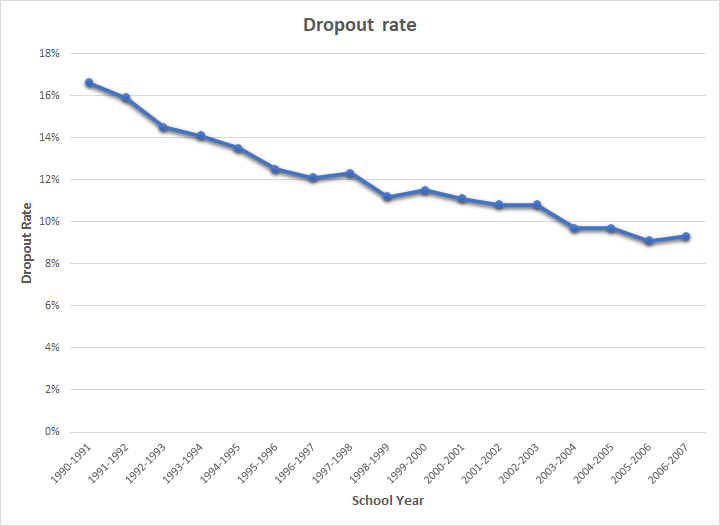95 High School Dropouts
Martha Lally; Suzanne Valentine-French; and Dinesh Ramoo
The status dropout rate refers to the percentage of 16- to 24-year-olds who are not enrolled in school and do not have high school credentials (either a diploma or an equivalency credential such as a General Educational Development [GED] certificate). The dropout rate is based on sample surveys of the civilian, non-institutionalized population, which excludes persons in prisons, persons in the military, and other persons not living in households. The 1990–1991 Canadian dropout rate was 16.6 percent. By the 2006–2007 school year, it had fallen to 9.3 percent (see Figure 6.13). This trend is seen in all parts of Canada. However, the decline is more apparent in the east. Rural regions tend to have higher dropout rates compared to the urban parts of Canada.
The dropout rate among high school students in the United States has declined from a rate of 12 percent in 1990, to 7 percent in 2013 (US Department of Education, 2015). The rate is lower for white students than for Black students, and the rates for both white and Black students are lower than the rate for Hispanic students. However, the gap between white, Black, and Hispanic students has narrowed (see Figure 6.13).

The dropout rate for males in 1990 was 12 percent, where it stayed until 2000. Thereafter the rate dropped to 7 percent in 2013. The dropout rate for females in 1990 was 12 percent, where it dropped to 10 percent in 2000, and 6 percent in 2013. From 1997 until 2012 the rate for males was appreciably higher than for females, while in 2013 the gender difference was minimal (US Department of Education, 2015).
Media Attributions
- Figure 6 13a © Dinesh Ramoo is licensed under a CC BY-SA (Attribution ShareAlike) license

